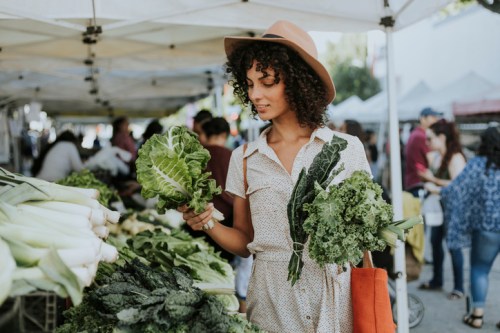It’s no secret that our planet is undergoing a climate change crisis. And if you’re someone who cares about the environment and tries to live a more sustainable lifestyle, you’ve likely spent some time considering the impact of your food choices.
Experts in This Article
food systems innovator, educator, ethicist, attorney and vice president of strategic initiatives at Sterling College
But when it comes to environmentally-friendly food and sustainable eating habits, there is a lot of misinformation out there about what matters most. Many well-intentioned environmentalists, meaning those who aspire to have a slightly lighter footprint, are operating under outdated or incomplete guidelines about how to improve the quality of their food choices. The good news is that there are a number of simple (and inexpensive!) shifts that you can make to shift your daily decisions from detrimental to drivers of change.
Before we dive in, it is important to address some context around the concept of making environmentally-friendly food choices top of mind in the first place. “There is substantial privilege associated with being able to consciously consider eating for the environment,” says food systems transformation agent, ethicist, and educator Nicole Civita, JD, LL.M., Vice President of Strategic Initiatives at Sterling College in Vermont. That doesn’t necessarily mean that making environmentally-friendly food choices has to come with a hefty price tag (more on that later), but it does mean that you need the luxury of time and attention, consistent access to food supply, and financial resources in order to even begin to consider the environmental impact of your food choices.
Whether you are just starting to explore environmentally-friendly food or you’re a seasoned expert, the tips below will be helpful in making better choices for the health of our planet and for ourselves. But as Civita cautions, “I think it’s important that we avoid heaping too much moralism on our plates!”
6 common environmentally-friendly food myths—and where to focus instead
Myth 1: Organic reigns king.
Buying produce and meat that’s labelled ‘Organic’ is often what people’s minds jump to when they think of improving the sustainability of their eating habits. While buying food produced without the use of synthetic fertilizers or pesticides certainly has its benefits, it is not the be-all and end-all answer.
“Organic agriculture has also become very industrialized and large scale,” says Civita. “Organic eggs are still grown in confinement. Organic dairy and beef cows are fed organic feed, but may be raised largely on concrete. The excrement from thousands of heads of cattle form enormous noxious waste lagoons with deleterious impacts on the environment, health, and the livability of surrounding communities.” In addition, many small farmers can’t afford to (or choose not to) go through with the USDA organic certification process, but do farm in alignment with, or even beyond, the organic standards. Point being, there are a lot of additional factors to consider beyond just the organic label.
A better way to approach purchasing decisions is by buying from local farmers and other suppliers where you can see or ask about their farming practices and principles. This way, you can make your own standards based on what’s most important to you, and spend your money on the things that rise to the top of your list.
Don’t know where to start? Checking out your options for local community supported agriculture (CSA) subscriptions is a great way to start to develop a relationship with a local farm and learn more about their production methods. You’ll also cut down on the food miles your meal has to travel to get to your plate.
Myth 2: Vegan or bust.
“Meat and dairy consumption—already at wildly unsustainable levels especially in wealthy nations—is on pace to increase by 70 percent by 2050,” says Civita. “We simply cannot continue to eat anywhere near as much meat as we collectively are at present.” With that in mind, you don’t have to go completely cold turkey (or no turkey) in order to improve your impact. In fact, it’s often the idea of shunning all animal products that keeps people from making any change in their diets at all.
Civita’s advice? Favor plant-based foods, but don’t deny yourself modest amounts of responsibly-raised meat and dairy. “Eating less meat and fewer animal source foods may also create some room in one’s food budget to pay a premium for animal products produced on pasture and in ways that help build soil health and sequester carbon,” Civita adds.
Myth 3: It’s what’s inside that matters.
“It’s a major misconception that we can just focus on the food and not the packaging,” says Civita. “Plastic is great for preventing food waste and is not always avoidable, but single use plastics are a forever environmental problem and so much of what we think we recycle ends up on someone else’s shores or worse, bobbing in the oceans.” Buying from bulk bins (bringing along your own glass jars if possible!) and choosing more eco-friendly packaging can go a long way in mitigating the environmental impact of food choices.
Myth 4: Environmentally-friendly food is all about purchasing power.
While the choices we make with our dollars at the grocery or even the farmers market are important, buying food is not the only way we can feed ourselves and give the planet a break. “There are so many wild food sources that we can incorporate into our diets that are incredibly nutritious, freely available, and astonishingly delicious,” says Civita. “I love thinking about eating with a little less reliance on agriculture, meaning eating that which grows on uncultivated land, or even eating invasive species.”
While it’s likely not reasonable for most of us to make most of our diets out of wild or foraged foods, you’d be surprised at what you can find once you start to look. “I’ve gotten more than a few amazing meals out of the dandelions (leaves and blossoms), purslane, knotweed, and nettles in my yard. I stay away from the fence line where there might be pesticides and get creative in the kitchen, displacing the need to buy as many veggies,” adds Civita.
For inspiration, check out the Instagram account of Pascal Baudar, a master at foraging and wildcrafting, or Alexis Nikole, a genius forager and comic who demystifies foraging with humorous, 80’s funk-inflected TikToks.
Myth 5: One person’s trash is another’s treasure.
“Mind boggling amounts of the food grown and produced in the world goes to waste,” according to Civita. In the United States, approximately 30-40 percent of food is never eaten, which accounts for the majority of our trash. Most wasted food ends up in landfills, where it generates methane, a particularly potent greenhouse gas.
“Food waste represents excess production: We’re growing much more food than we need,” explains Civita. “This means that the environmental footprint of agriculture is much larger than it needs to be, and agriculture is a leading cause of deforestation.” If food waste were a country, it would be the world’s third-largest greenhouse gas emitter, after China and the United States.
The solution? Simply waste less food. By buying, cooking, and plating only what you need, you have a ripple effect of less land and water use for agriculture, less soil erosion due to large-scale agriculture projects, and less air and water pollution. “By reducing waste and making the food system more efficient, we’re also better positioned to feed the growing world population,” Civita adds.
Myth 6: Grocery bills will go up.
This brings us back to the beginning. While it is a privilege to be able to consider eating for the environment, that doesn’t mean that it has to be pricey or something that only a certain subset of the population can do. Many of the strategies listed above—including reducing food waste, favoring plants, and foraging—can be easy to implement, save time and/or money, and don’t put you in the position to be obsessively scanning labels or parsing eco-certifications.
“These strategies won’t guard against all environmental ills, but if widely followed, they can drastically reduce the carbon and water footprints of your food while also addressing other ethical problems in the food system,” says Civita. And if it all still seems out of reach, it is important to remember that focusing on individual dietary decisions is not the only way to drive change in our food system and overall sustainability initiatives. Civita recommends getting involved in food activism groups such as HEAL Food Alliance as an alternative (or complement to) considering what’s on your plate.
Oh hi! You look like someone who loves free workouts, discounts for cult-fave wellness brands, and exclusive Well+Good content. Sign up for Well+, our online community of wellness insiders, and unlock your rewards instantly.
Sign Up for Our Daily Newsletter
Get all the latest in wellness, trends, food, fitness, beauty, and more delivered right to your inbox.
Got it, you've been added to our email list.










